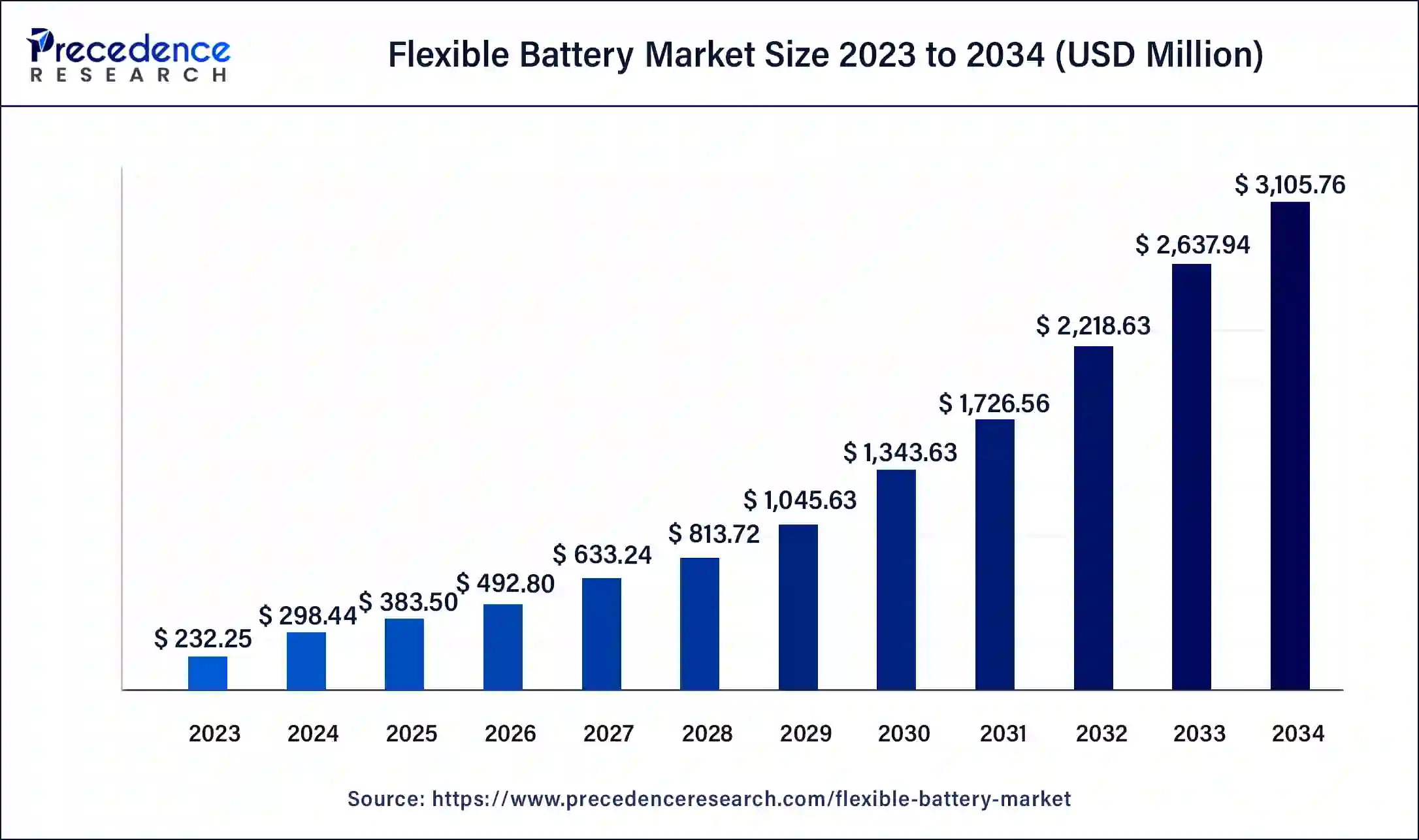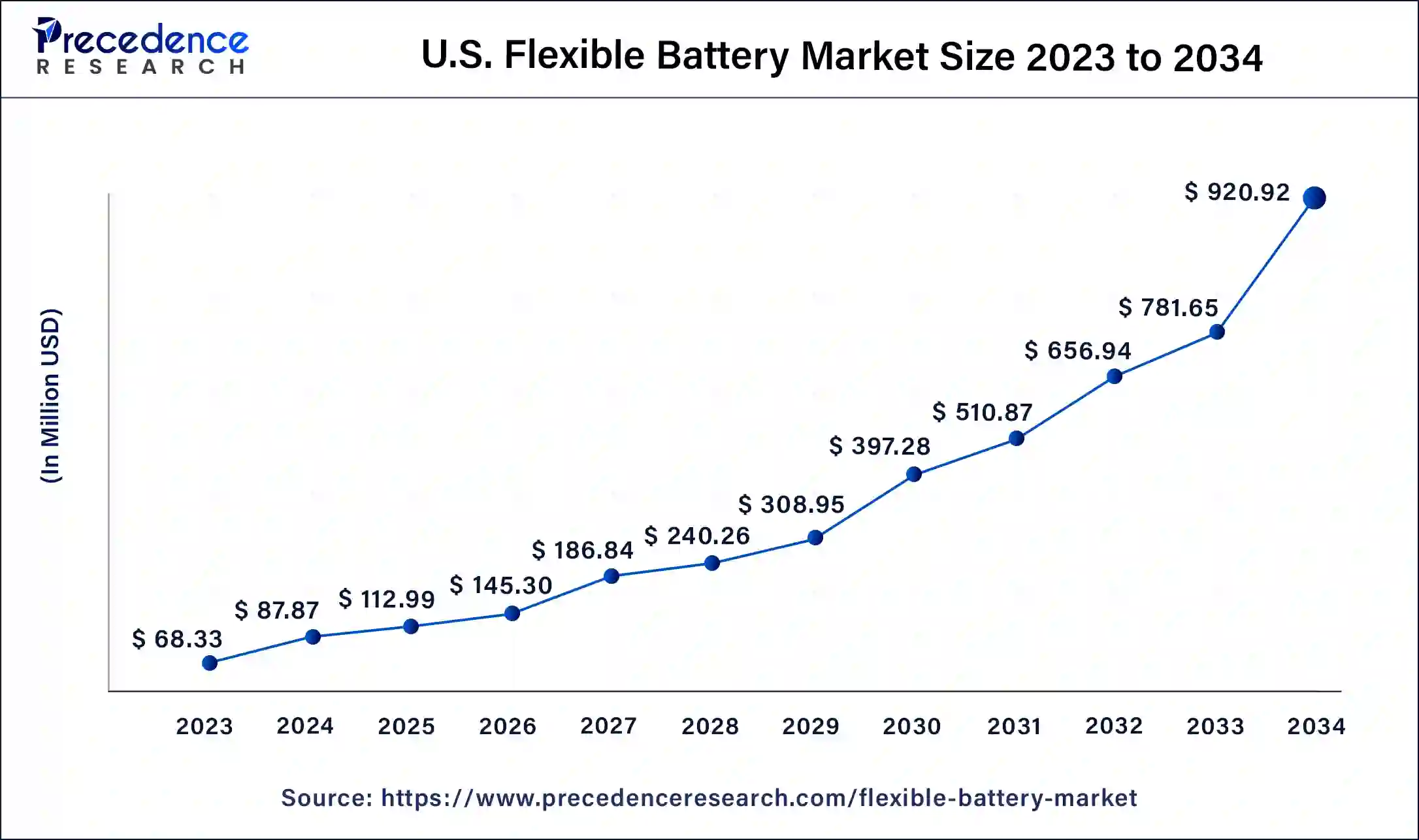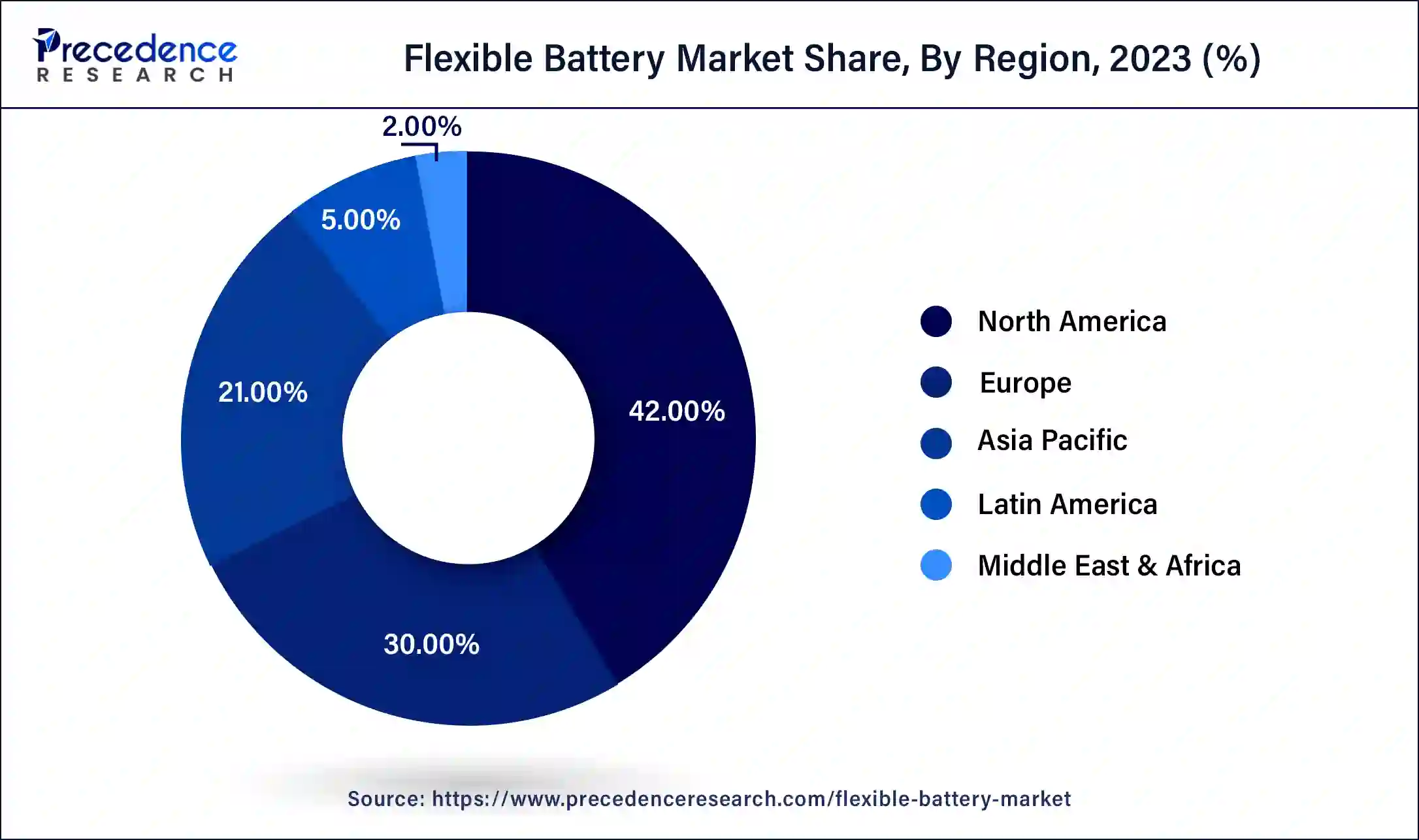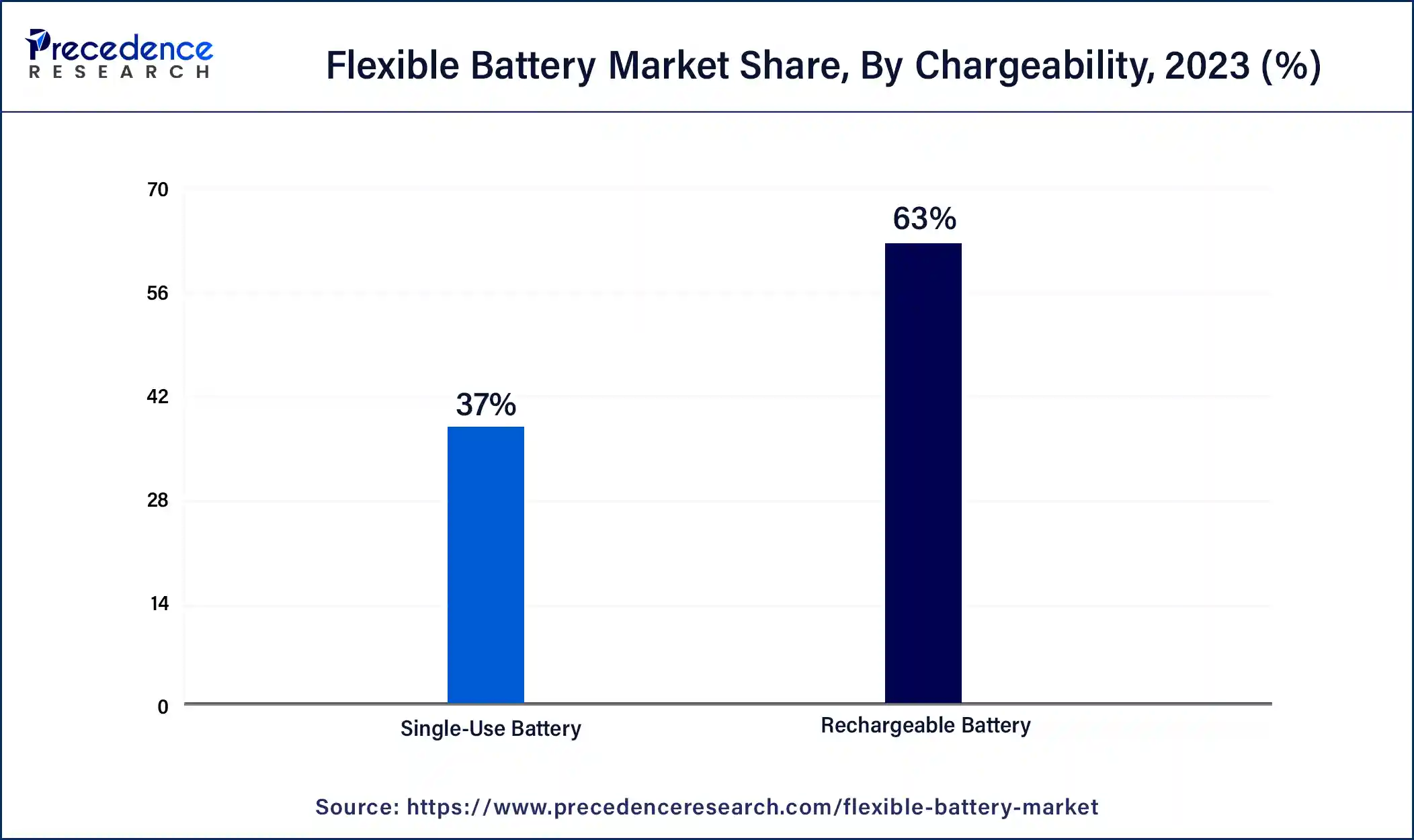List of Contents
Flexible Battery Market Size and Forecast 2024 to 2034
The global flexible battery market size accounted for USD 298.44 million in 2024 and is predicted to reach around USD 3105.76 million by 2032, expanding at a CAGR of 26.40% from 2024 to 2034. The North America flexible battery market size reached USD 97.55 million in 2023.

Flexible Battery Market Key Takeaways
- North America contributed more than 42% of revenue share in 2023.
- Asia Pacific is estimated to expand the fastest CAGR between 2024 and 2034.
- By product type, the advanced Lithium-Ion batteries segment has held the largest market share of 32% in 2023.
- By product type, the flexible zinc-carbon batteries segment is anticipated to grow at a remarkable CAGR of 29.8% between 2024 and 2034.
- By chargeability, the single-use battery segment generated over 62% of the revenue share in 2023.
- By chargeability, the rechargeable battery segment is expected to expand at the fastest CAGR over the projected period.
- By voltage, the 1.5V To 3V segment had the largest market share of 52% in 2023.
- By voltage, the above 3V segment is expected to expand at the fastest CAGR over the projected period.
- By application, the consumer electronics segment had the largest market share of 43% in 2023.
- By application, the smart packaging segment is expected to expand at the fastest CAGR over the projected period.
U.S. Flexible Battery Market Size and Growth 2024 To 2034
The U.S. Flexible Battery market size was valued at USD 68.33 million in 2023 and is expected to be worth USD 920.92 million by 2034, growing at a CAGR of 26.49% from 2024 to 2034.

North America held the largest revenue share of 42% in 2023. In North America, the flexible battery market experiences significant growth driven by the increasing adoption of wearables, IoT devices, and advanced medical applications. The region's strong technological infrastructure and innovative industries contribute to the expanding use of flexible batteries across various sectors, while the demand for energy-efficient and compact power sources fuels the market's development.

Asia Pacific is estimated to observe the fastest expansion. In Asia Pacific, the market surged due to the proliferation of consumer electronics and the rapid development of flexible displays and wearables. Growing investments in research and development, particularly in countries like South Korea and Japan, boost the demand for flexible batteries to power next-generation devices, further accelerating market expansion.
Market Overview
The flexible battery market encompasses the production and adoption of batteries with flexible and bendable characteristics. These batteries are typically lightweight and versatile, capable of conforming to various shapes and form factors, such as wearables, IoT devices, and medical applications. They offer advantages in terms of design flexibility and compatibility with curved or irregular surfaces, making them ideal for applications where traditional rigid batteries would be impractical. The market's growth is driven by the increasing demand for compact, flexible power sources in emerging technology sectors, including wearables, printed electronics, and flexible displays.
Flexible Battery Market Growth Factors
- The proliferation of wearables, such as smart clothing and flexible displays, demands reliable, compact, and flexible power sources, boosting the market.
- The ever-growing IoT sector relies on flexible batteries to power sensor-laden devices for monitoring and data collection.
- Compact and flexible batteries are essential for smartphones, tablets, and other portable electronic devices.
- Flexible batteries are key to energy-efficient and eco-friendly technologies like solar-integrated wearables.
- Ongoing efforts to make batteries even smaller and more flexible, ideal for microdevices.
- Innovations in materials and nanotechnology enhance battery performance.
- Tailored flexible batteries to meet specific application requirements.
- The shift toward electric vehicles (EVs) and e-mobility solutions presents a substantial driver. Flexible batteries can be incorporated into EV design, providing lightweight and adaptable power sources for vehicles.
- Flexible batteries have the potential to play a pivotal role in storing energy from renewable sources, such as solar and wind, for residential and commercial use.
- Opportunities in the deployment of flexible batteries to power remote environmental monitoring sensors, weather stations, and agricultural IoT devices ofprecision agriculture and sustainability initiatives.
Market Scope
| Report Coverage | Details |
| Market Size by 2034 | USD 3105.76 Billion |
| Market Size in 2023 | USD 232.25 Billion |
| Market Size in 2024 | USD 298.44 Billion |
| Growth Rate from 2024 to 2034 | CAGR of 26.40% |
| Largest Market | North America |
| Base Year | 2023 |
| Forecast Period | 2024 to 2034 |
| Segments Covered | Product Type, Chargeability, Voltage, Application, and Region |
| Regions Covered | North America, Europe, Asia-Pacific, Latin America, and Middle East & Africa |
Market Dynamics
Driver
Wearable electronics demand and IoT proliferation
The flexible battery market is experiencing remarkable growth driven by the rising demand for wearable electronics and the widespread adoption of the Internet of Things (IoT). These gadgets rely on dependable and flexible power sources that enable them to maintain extended performance and offer users greater convenience. This surging demand for wearable electronics necessitates advanced flexible battery solutions, making them a pivotal component of these cutting-edge technologies.
Moreover, the IoT revolution has led to a massive surge in connected devices, from smart home appliances to industrial sensors. Many of these IoT devices are compact and require small, flexible power sources to function efficiently. As IoT applications continue to expand across various industries, the demand for flexible batteries follows suit. These power sources empower these devices to operate reliably, ensuring that the IoT infrastructure remains robust. As the wearable electronics market and IoT ecosystem continue to grow, the flexible battery market is poised for sustained expansion, offering innovative energy solutions that drive these technological advancements.
Restraint
Technical limitations and manufacturing complexities
Flexible batteries generally have lower energy densities compared to conventional rigid batteries. This limitation affects their use in high-energy-demand applications, such as electric vehicles. Moreover, flexibility often leads to reduced cycle life and slower charge/discharge rates. These technical limitations hinder the adoption of flexible batteries in critical applications such as smartphones and EVs.
Moreover, producing flexible batteries with consistent quality and at scale is a complex process. The materials used need to be flexible yet durable, which can be technically challenging to achieve. Ensuring reliable performance, safety, and cost-effectiveness presents manufacturing complexities. As a result, manufacturers need to invest in specialized equipment and materials. These complexities can increase production costs and, in turn, the price of flexible batteries, potentially limiting their market growth, especially in price-sensitive applications. Addressing these technical and manufacturing challenges is crucial to unlock the full potential of flexible batteries in various industries.
Opportunity
Medical implants and the automotive sector
The flexible battery market experiences significant demand surges from the medical implants and automotive sectors due to their unique requirements. In the medical field, the use of medical implants, such as pacemakers and neurostimulators, heavily relies on flexible batteries to ensure safe and efficient operation within the human body. These batteries must be bendable to fit within compact implantable devices and offer reliable power sources, contributing to the overall well-being of patients. As the medical industry increasingly adopts innovative implantable technologies for various health conditions, the demand for flexible batteries is set to grow steadily.
Moreover, the automotive sector fuels market demand by incorporating flexible batteries into electric vehicles (EVs) and hybrid electric vehicles (HEVs). The automotive industry seeks lightweight and adaptable power sources to support the trend toward electrification and the development of autonomous vehicles. Flexible batteries are integrated into these vehicles to power various systems, such as electronic control units, sensors, and even the potential for flexible and conformal battery packs. As the automotive sector evolves with an emphasis on sustainability and advanced vehicle technologies, the flexible battery market is poised to benefit from this transformation.
Product Type Insights
According to the product type, the advanced Lithium-Ion batteries segment has held a 32% revenue share in 2023. Advanced Lithium-Ion Batteries, a product type in the flexible battery market, represent the cutting-edge in energy storage technology. They offer high energy density, longer cycle life, and improved efficiency compared to conventional batteries. Trends indicate a growing preference for lithium-ion batteries due to their versatility and applications in various sectors, including consumer electronics, EVs, and renewable energy solutions. Continuous research focuses on enhancing their safety, charging speed, and overall performance to meet evolving market needs.
The flexible zinc-carbon batteries segment is anticipated to expand at a significant CAGR of 29.8% during the projected period. Flexible zinc-carbon batteries, another product type, are designed for lightweight and portable applications, such as toys and low-power electronic devices. Their trend primarily involves improving their environmental friendliness, efficiency, and durability, making them more competitive in specific niche markets. These batteries are ideal for devices that demand flexible power solutions and emphasize sustainability. Their development aims to expand their applications beyond conventional uses, including powering wearables and small IoT devices.
Chargeability Insights
Based on the chargeability, the single-use battery segment held the largest market share of 62% in 2023. These batteries are also known as non-rechargeable or disposable batteries, are intended for one-time use. They are commonly used in devices with low-power demands, such as remote controls and toys. The trend in single-use flexible batteries centers around improving energy density and environmental impact. Manufacturers are developing eco-friendly disposable batteries with reduced toxic materials and increased energy efficiency, aligning with consumer preferences for more sustainable power sources.

On the other hand, the rechargeable batteries segment is projected to grow at the fastest rate over the projected period. In the flexible battery market, rechargeable batteries are designed to be recharged multiple times during their operational lifespan. These batteries are favored for their sustainability and cost-efficiency, making them popular in applications such as portable electronics and electric vehicles. The trend in rechargeable flexible batteries includes advancements in energy density, extended cycle life, and rapid charging capabilities, catering to the growing demand for longer-lasting and faster-charging battery solutions.
Voltage Insights
The between 1.5V and 3V segment had the highest market share of 52% in 2023 on the basis of the voltage. In the flexible battery market, the segment comprising batteries with voltages between 1.5V and 3V is particularly relevant for low-power portable electronics, wearable devices, and various sensors. These batteries cater to applications that require modest power levels and flexibility. The trend in this segment is the continued miniaturization of electronic devices and the increasing demand for thin, lightweight, and adaptable power sources.
The above 3V segment is anticipated to expand at the fastest rate over the projected period. In the segment of flexible batteries with voltages above 3V, the market primarily focuses on applications demanding higher power output, including certain medical devices, smart cards, and some consumer electronics. The trend in this category is the development of advanced, high-energy-density batteries with enhanced performance characteristics. As these applications often require long-lasting power sources, research and innovation are directed toward improving the capacity and efficiency of batteries in this voltage range. The adoption of flexible high-voltage batteries in various specialized devices continues to rise.
Application Insights
The consumer electronics segment had the highest market share of 43% in 2023 based on the application. The consumer electronics segment in the flexible battery market pertains to the growing demand for flexible batteries in devices such as smartphones, wearables, and flexible displays. As consumers seek sleek and ergonomic designs, flexible batteries are integrated to power these devices without compromising form or function. This trend is driven by the need for longer battery life, faster charging, and lighter devices, making flexible batteries a key component in enhancing the user experience.
The smart packaging is anticipated to expand fastest over the projected period. In the context of the flexible battery market, smart packaging involves the integration of flexible batteries into packaging materials. These batteries power various smart and interactive packaging solutions like intelligent labels, freshness indicators, and shipment tracking systems. The growth in e-commerce and the need for real-time information on product quality, location, and authenticity are driving the adoption of flexible batteries in smart packaging. This trend is aligned with the rising demand for sustainable and intelligent packaging solutions across industries.
Flexible Battery Market Compnaies
- LG Chem Ltd.
- Panasonic Corporation
- Samsung SDI Co. Ltd.
- Ultralife Corporation
- Blue Spark Technologies, Inc.
- BrightVolt
- Cymbet Corporation
- Enfucell Oy
- Imprint Energy
- NEC Energy Solutions
- Neware Technology Limited
- Solicore, Inc.
- Ultralife Corporation
- Vinamul Polymers
- VARTA Microbattery GmbH
Recent Developments
- In 2022, STMicroelectronics unveiled the L9961 battery-management-system (BMS) device, boosting lithium battery performance and longevity. This versatile solution enhances Li-ion and Li-polymer batteries' safety and efficiency, with applications ranging from cordless power tools to medical devices.
Segments Covered in the Report
By Product Type
- Advanced Lithium-Ion Batteries
- Flexible Zinc-Carbon Batteries
- Thin Film Batteries and Printed Batteries
- Laminar Lithium Polymer Batteries
By Chargeability
- Rechargeable Battery
- Single-Use Battery
By Voltage
- 1.5V
- 1.5V To 3V
- Above 3V
By Application
- Transportation and Logistics
- Smart Packaging
- Healthcare
- Consumer Electronics
- Others
By Geography
- North America
- Europe
- Asia-Pacific
- Latin America
- Middle East and Africa
For inquiries regarding discounts, bulk purchases, or customization requests, please contact us at sales@precedenceresearch.com
Frequently Asked Questions
Ask For Sample
No cookie-cutter, only authentic analysis – take the 1st step to become a Precedence Research client